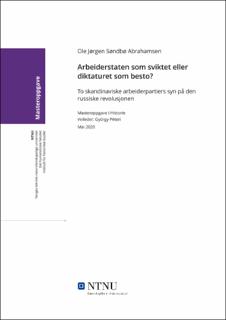| dc.contributor.advisor | Péteri, György | |
| dc.contributor.author | Abrahamsen, Ole Jørgen Søndbø | |
| dc.date.accessioned | 2021-09-13T16:03:34Z | |
| dc.date.available | 2021-09-13T16:03:34Z | |
| dc.date.issued | 2020 | |
| dc.identifier | no.ntnu:inspera:59158742:14066367 | |
| dc.identifier.uri | https://hdl.handle.net/11250/2775542 | |
| dc.description.abstract | I denne avhandlingen diskuterer jeg hvilke forestillinger Det norske Arbeiderpartiet (DNA) og Sveriges socialdemokratiska arbetareparti (SAP) hadde om den russiske revolusjonen 1917-40. Diskusjonen er gjort på grunnlag av diskursen i partienes hovedorgan, ideologiske tidsskrifter og diverse partilitteratur. Perioden som blir undersøkt markerer inngangen til den sosialdemokratiske tidsalderen i Norge og Sverige. De to partiene som undersøkes hadde ulike veger til sin dominerende posisjon. DNA opplevde en radikal vending i 1918, var i perioden 1919-23 medlem i Komintern, og anså på 1920-tallet at revolusjonær klassekamp var vegen til en sosialistisk fremtid. På 1930-tallet beveget partiet seg gravis mot å bli et reformistisk sosialdemokratisk parti. Gjennom dette besto den russiske revolusjonen som en viktig inspirator. I avhandlingen viser jeg at DNA anså Sovjet-Russland og senere Sovjetunionen for å være en arbeiderstat, som også DNA ville etterstrebe. Etter ikke-angrepspakten med Nazi-Tyskland skjedde det et brudd, og den russiske revolusjonen gikk fra å være en historie om arbeiderbevegelsens mulighet til å realisere et nytt samfunn til å bli en historie om despotisk kapring av arbeiderstaten som søkte å nå dette målet. Sovjetunionen ble for DNA diktaturet som sviktet arbeiderbevegelsen den hevdet å representere. SAP var et reformistisk sosialdemokratisk parti som motsatte seg den russiske revolusjonen helt fra bolsjevikenes maktovertakelse i 1917. Oktoberrevolusjonen var sett som en politisk revolusjon gjennomført med mål om å etablere et voldsdiktatur i et underutviklet land uten forutsetningene til å skape et sosialistisk samfunn. Den russiske revolusjonen ble sett i analogi med den franske revolusjonen gjennom hele perioden, som en revolusjon som gikk fra en radikal fase til en stalinistisk – bonapartistisk – konsolidering av diktaturet. Til slutt gjør avhandlingen en sammenligning av de gjeldende tendensene i de to partienes diskurs om den russiske revolusjonen. Mitt argument er at visse tendenser i DNA nærmet seg narrativet som hadde blitt ført i SAP gjennom hele perioden. Jeg viser at forestillingene om den russiske revolusjonen i SAP hadde en sterk grad av kontinuitet. Bildet i DNA var mer komplisert, og endret seg i løpet av perioden. DNAs forestillinger nærmet seg diskursen i SAP på noen spesifikke punkter, mens de på andre punkter ikke gjorde dette. Partienes syn på den russiske revolusjonen inneholdt både likheter og distinkte særpreg gjennom hele perioden. | |
| dc.description.abstract | In this thesis, I discuss the perceptions, imaginations, and notions that the Norwegian Labour Party (DNA) and the Swedish Social Democratic Party (SAP) had about the Russian Revolution 1917-40. The thesis analyses the discourse in the party newspapers, journals, and literature. The discussion covers the beginnings of what has been termed “The Age of Social Democracy” in Norway and Sweden. The two parties had different roads to their position of dominance. DNA did go through a radical change in 1918. Between 1919-23, DNA was member of the Third Communist International and thought that socialism could only be achieved through revolutionary class warfare. In the 1930s, the party gradually abandon its earlier radicalism and increasingly assumed a reformist social-democratic complexion. Nevertheless, the Russian Revolution remained an important inspiration through the whole period. In the thesis, I argue that the Norwegian Labour Party did see Soviet Russia, and later the Soviet Union as a worker´s state much akin to what they themselves wished to achieve. The Nazi-Soviet pact of 1939, however, crushed this optimism. In the Norwegian Labour Party´s eyes, the Russian Revolution was transforming into a history of decay; were a dictatorship had betrayed the labour movement it claimed to represent. From the very moment the Bolsheviks seized power, the Swedish Social Democratic Party was opposed to the Russian Revolution. The October Revolution was viewed as a political revolution carried out with the establishment of an oppressive dictatorship in an underdeveloped country without the preconditions for socialism. The Russian Revolution was seen as analogous to the French Revolution throughout the period; as a revolution moving through a radical phase to a Stalinist – Bonapartist – consolidation of the dictatorship. imagined in analogy with the French Revolution throughout the whole period, the story of the revolution was the road from a radical phase to a Stalinist – Bonapartist – consolidation of the dictatorship. The thesis also offers a comparative discussion of the discourse in both parties. Here the central argument of the thesis is that the discourse in the DNA moved closer to the perceptions prevalent in the SAP. I show that the perceptions characterising thought in the SAP persisted continuously throughout the period. The story of DNA in this respect, was more complicated as their perceptions changed and in some specific areas converged with the discourse prevailing in the SAP, while in other areas no approximation occurred. The two parties’ mental images of the Russian Revolution did exhibit similarities as well as dissimilarities with one another throughout the period. | |
| dc.language | | |
| dc.publisher | NTNU | |
| dc.title | Arbeiderstaten som sviktet eller diktaturet som besto? To skandinaviske arbeiderpartiers syn på den russiske revolusjonen | |
| dc.type | Master thesis | |
